Getting Started-Setting Forms and Pouring the Concrete Slab
Your wood fired steam boiler is is going to weigh several tons, so it's imperative to construct a proper foundation for it to sit on. Of course, prior to taking this step you want to make sure a water supply is located adjacent to the boiler location. If you're in a warm area of the world, this is an easy task.
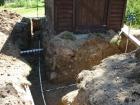
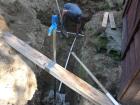
In our harsh northwestern USA mountain climate, we must bury water lines nearly six feet deep to prevent freezing. Obviously you want to accomplish this task before building your boiler to avoid upsetting the ground nearby which could weaken your foundation. Once you have your freeze proof faucets installed, temporarily secure them in place as shown so they won't shift when backfilling the ditch.
When you have selected your location and installed a water supply, it's time to begin setting the forms for your concrete slab. Begin by leveling an area slightly larger than the slab itself will occupy. It can't be emphasized enough to properly pack the soil before setting your forms and pouring concrete. At every step while setting your concrete forms, ensure you have everything level and square.
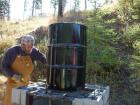
By now you will have calculated the size your structure will need to be to hold your boiler tank and surround it with blocks. I chose 6" X 8" X 16" standard concrete blocks for this job, allowing for 2" of clearance between the walls and the front and rear of the boiler tank.
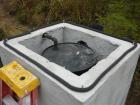
It's somewhat wider on the left and right so the unit can hold larger, longer logs. This also gives enough room to run a chimney brush inside the unit to clean out soot and creosote, while still ensuring most of your heat goes into the tank itself rather than out the chimney and wasted if your clearance was too large.
This project uses a food grade 55 gallon barrel as a boiler tank, which experience over many years has shown to be an excellent compromise between price and functionality, while still providing many years of service before requiring replacement. Used drums are available for around $20 to $40, which helps to keep the cost of your project low and were selected for this job due to their excellent track record in our previously built propane fired boilers. It was our intention with this project to wean our organic mushroom farm completely off fossil fuels.
Once your ground is properly packed, begin building your concrete forms as shown. I used 2 X 6 lumber to provide a 5 1/2" slab depth. Be sure to get the forms perfectly square and level to ensure your future boiler sits straight and plumb. Nothing will make your project look amateur built more than being out of square or off level, so take an extra few minutes now to ensure you're not embarrassed later after all your hard work. I set the forms 24" longer in the front than the boiler was going to occupy to give a small 'porch' to set logs during loading. This also provides a snow and ice free platform to stand on later when adjusting the pressure switches or servicing the electrical components.
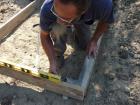
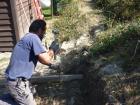
Measure where the voids in your concrete blocks are going to be later, and drive steel reinforcing bar into the ground at least 24" deep in these spots. Cut the rebar so when driven into the ground, they protrude at least several inches above the finished slab where the boiler will sit as shown. This ensures your blocks will not shift on the slab once you've extended the rebar as you build the boiler, always filling the voids in the blocks with concrete and steel as you go.
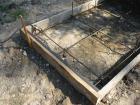
You'll notice on the front edge of the boiler slab is a length of 1" steel angle iron. This was put in place and welded to the rebar system prior to pouring the concrete. The result is a steel protective edge to prevent damage to the concrete slab from dropped logs, etc., later. It's not absolutely mandatory, but makes for a more professional job.
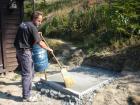
Finally, after pouring the concrete into your forms and troweling it smooth, allow the concrete to begin to set, and then rough it up with a stiff bristled broom as shown. This serves two purposes. First it allows for a rough surface for your first layer of mortar to adhere to the slab and first row of blocks, and second, it provides a slip-resistant surface for you to stand on when loading logs into the boiler later. Allow your fresh slab to cure for at least 48 hours before continuing. Notice the rebar in the future boiler location protruding from the surface of the concrete. These were located to be in the center of the voids in our concrete blocks as we build the boiler. These rebars will be gradually extended upwards as we build the boiler, filling the voids in our blocks with concrete all the way to the top.
Building the Boiler Fire Box
Now comes the fun part, designing and building the firebox. We're building a solid concrete structure by using blocks and filling all the voids with steel-reinforced concrete. This provides a tremendous thermal mass, so that once it's heated up, it only takes a very small fire to keep it going. The thermal mass helps to regulate the temperature so we don't experience spikes or rapid declines in steam pressure when we load wood, or need to load wood. However, concrete and standard masonry mortar doesn't hold up well to the high temperature which will be encountered in our boiler.
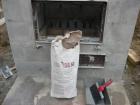
Therefore, we'll be lining the concrete walls of our firebox with firebrick. For the joints, we chose a brand called HeatStop 50 refractory mortar and it worked out very well for us. It should be noted this mortar sets up pretty fast, so only mix as much as you're going to use within a few minutes as it's not recommended to add more water once it begins to set.
Engineers many years ago discovered a wood-fired appliance is much more efficient if the intake air is super-heated prior to being fed into the combustion area.
By pre-heating the intake air, we don't have that -30F air entering fire box, which would waste our firewood by making it work harder to overcome this cold air to heat our steam vessel.
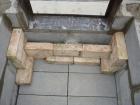
The picture to your left, taken prior to mortaring in the blocks and firebrick shows how I designed the combustion air preheating system. You'll notice on the bottom are six concrete blocks laying on their sides so the voids are horizontal. The air intake is a 5" sleeve centered just below the door opening. We'll get back to constructing that shortly. First, notice the used firebrick. If you can find 50+ year old firebrick the way I did, you'll get a better product and save money too. Check second hand stores and used building materials outlets in your area to find them.
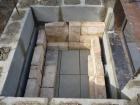
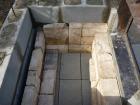
You can see from the pre-construction layout pictures on the left and right that once the blocks and firebricks are mortared into place, combustion air will enter through the sleeve, travel down and under the firebox where it will get heated, and then rise up to enter at the back of the combustion chamber as shown in the pictures below taken much later.
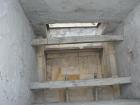
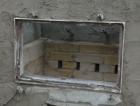
The actual firebox was built after the rest of the boiler was completed to prevent accidental damage from dropped tools, blocks, mortar, etc., which undoubtedly occurs during construction.
To keep the intake air channel at the rear of the boiler open and to prevent damage to the firebrick
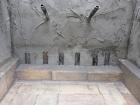
on the inevitable day a log gets carelessly tossed in and hits the back wall, you can see from the picture on your right that angle iron was placed vertically and the firebricks were then pressed tightly against this angle iron and mortared securely into place. A few half bricks were then used in the middle layer on the back wall to provide openings for the preheated air to enter the firebox.
Auxiliary Air Intakes
Smoke is unburned wood gasses. Often, at the tips of the flames the available oxygen has already been consumed and the fire is starving for air, causing the unburned wood gasses to be expelled as smoke. Not only does this create unnecessary particulate emission and creosote buildup in the chimney, but your firewood is being wasted. You may have noticed in the last two pictures above a pair of black iron pipes entering the combustion chamber at the rear.
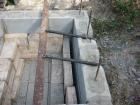
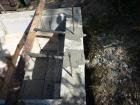
These are the auxiliary air intakes. By providing a supply of air directly into the tips of the flames, these gasses are burned with the resulting hotter, leaner fire using less wood and producing considerably less smoke. These air intakes must be installed when the original structure is built, so be sure to plan ahead and calculate where your finished firebox is going to sit. I suggest using my method of actually laying the firebricks in place so you can eyeball exactly what you have. The Auxiliary air intakes need to be right over the fire so the air can be preheated as it enters, and the fresh air they supply needs to enter at the exact right spot at the tips of the flames.
If you get them too high, they do little good, and if they're too low they will interfere with loading firewood, reducing the size of your firebox and how much wood can be loaded into it on cold winter nights when you really don't want to be setting your alarm clock for 2 A.M. just to go outside and feed the beast. After knocking out an opening in the blocks with a hammer, the pipes were cut and laid into place, temporarily supported by the square tubing while the mortar was applied and left overnight to cure. Be sure to cut the pipes at an angle so the air will be pulled in more efficiently by the fire's convection.